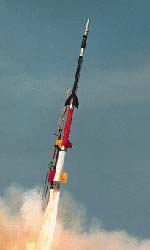About Wallops
Text Size
Established in 1945 under NASA's predecessor, the National Advisory Committee for Aeronautics (NACA), Wallops is one of the oldest launch sites in the world. Our support of scientific research and orbital and suborbital payloads places us at the center of NASA's space and Earth sciences.
Built to conduct aeronautical research using rocket-propelled vehicles, Wallops launched its first rocket on July 4, 1945. Since then, we have fulfilled our mission with the launch of more than 14,000 rockets.
Over the years, our launch range has grown to include six launch pads, assembly facilities and state-of-the-art instrumentation. In addition, our mobile launch facilities enable our scientists and engineers to launch rockets around the world. The science dictates the launch site; we provide the expertise and instrumentation to launch, track, acquire data and recover the payload.
Wallops philosophy-then and now-is to provide a fast, low-cost and highly flexible response to meet the needs of America's aerospace technology community and science researchers. In addition to supporting NASA's bright stars-Project Mercury, Project Gemini, Project Apollo, and the Space Shuttle missions-we have a proud history of partnering with a diverse customer base to support and launch small projects that contribute significantly to Earth and space science.
Recognized as a role model for pioneering productive and innovative government, industry and academic partnerships, Wallops will continue to serve as a key facility for operational test, integration and certification of NASA and commercial next-generation, low-cost orbital launch technologies. Under the Mission 2005 Plan, the following Mission Themes are identified, each containing several proposals.
Enabling Scientific Research
Support the Earth and Space Science Enterprises by providing low-cost, highly capable suborbital and orbital carriers, mission management, and mission services to enable Earth and space science research.
- Provide research carriers and science platform missions, including sounding rockets, balloons, aircraft, and carriers for Shuttle, and provide brokering services for other carriers such as Uninhabited Aerial Vehicles (UAV) and non-NASA aircraft.
- Develop new technologies and applications for WFF carriers such as use of balloons for planetary and Earth science missions, and sounding rockets for planetary entry demonstrations.
- Develop, manage, and implement small orbital science missions.
- Provide specialized mission services through use of the WFF Test Range.
- Conduct Earth science measurements supporting global climate change and coastal research.
- Lead the application of balloon technology to Mars Exploration missions as selected or assigned.
Enabling Aerospace Technology and Facilitating the Commercial Development of Space
Support the Aerospace Technology and Human Exploration and Development of Space Enterprises by providing advanced aerospace technology development, testing, operational support, and facilitation of the commercial launch industry to enable frequent, safe, and low-cost access to space.
- Serve as a NASA test site for demonstrating space launch technologies.
- Support development of advanced range technologies that improve safety and reduce launch costs.
Enabling Education, Outreach, and Innovative Partnerships
Support other NASA goals and objectives by providing science and technology education and outreach programs including innovative partnerships with academia, other government agencies, and industry.
- Provide student flight projects to teach students the processes associated with conducting aerospace and scientific research.
- Seek new opportunities to collaborate with regional colleges and universities, especially Historically Black Colleges and Universities (HBCUs).
- Continue effort with WFF tenants and regional government organizations to create new business opportunities for WFF.



